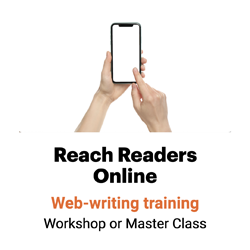Web visitors spend only a few seconds on a webpage
Tick tock. Visitors spend less than four seconds on 25% of the web pages they visit, according to a study by University of Hamburg and University of Hannover researchers.

Those visits peaked at two to three seconds.
That means that within two to three seconds, web visitors decide that about a quarter of the pages they visit aren’t right for them.
But the longer web visitors stay, the longer they’ll stay.
Should I stay or should I go?
If you can get your visitors to spend 10 seconds on your web page, they’ll likely stay longer. And the longer they stay, writes usability expert Jakob Nielsen, the longer they’ll stay.
To learn that, a researcher named Chao Liu and colleagues from Microsoft Research crunched the numbers on page visit durations for more than 200,000 web pages over nearly 10,000 visits. They learned that the amount of time users spend on a web page follows a “Weibull distribution.”
Easy for them to say.
Weibull is a reliability-engineering model that analyzes the time it takes components to fail. Given that it’s worked fine until now, the model says, it will likely fail at X time.
Most web pages age “negatively.” That is, the longer visitors stay, the longer they’re likely to stay.
How do you keep them longer?
Meet the 30-3-30 test
Back in the mid-20th century, academician and communication theorist Clay Schoenfeld recommended the 30-3-30 rule. That is, you should present your message as if one-third of your audience will give you:
- 30 minutes. These folks are readers, and don’t we wish there were more of them!
- 3 minutes. They’re not reading the text. Instead, they’re flipping, skimming and scanning for key ideas. To reach them, you need to lift your ideas off the screen with display copy.
- 30 seconds. With a 30-second attention span, these folks are lookers. They don’t read words. They’ll learn whatever they can through an image and a bold headline.
That’s for print. Online, add another 3, for people who will give you:
- 3 hours. These folks are researchers. They dive deep for data. Give them bottomless wells of information — libraries and archives of white papers, detailed product specs, PowerPoint decks, full texts of speeches and presentations, and so forth.
“The Internet is for everybody,” write Daniel A. Cirucci and Mark A. Tarasiewicz of the Philadelphia Bar Association. “It’s for the 30-second reader, the three-minute reader, the 30-minute reader and even the three-hour junkie.”
So what does Schoenfeld’s rule look like today? That depends on whom you ask. You may want to pass one of these three tests:
1. 10/30/2 test
According to user research by Microsoft Research, web visitors:
- Decide whether to stay on a page within 10 seconds
- Are likely to stay longer if they make it over the 30-second hump
- At that point, may stay as long as 2 minutes or more
These people don’t read content word by word. So make sure you create scannable content: a visual hierarchy of headings, short paragraphs, and lots of white or negative space.
2. 10/21/2 test
According to an analysis of 50,000 page views by a highly educated European audience:
- Most web visitors stay for 10 seconds or less.
- The average amount of time Americans linger on a web page is 21 seconds.
- About 10% of web views extend beyond 2 minutes.
These folks don’t read on the web. In fact, they read a total of just 20% of the words in a piece of content. Increased scannability can help them find what they are looking for as they scan any new page on your website.
3. 3/10/more test
And that University of Hamburg study? It suggests that you pass the:
3-second test. Hook visitors within two or three seconds. The first question readers ask when they land on a page is “What kind of page is this?” Is it:
- A list of products they might want to buy?
- A forum that might answer their question?
- An article with information they’re seeking?
- A form they can use to book their vacation hotel room?
- An ad?
If they can’t tell within a couple of seconds, chances are you’ll lose them altogether.
Clear page design helps. So make sure your article page looks like an article page, your forum looks like a forum and your ad looks like an ad.
Your web visitors should also grasp instantly what the page is about and why it’s relevant to them. A solid headline and deck will help you make your point quickly.
One-quarter of web pages don’t make it past the three-second scan. But if your web page does pass the three-second test, according to the German researchers, web visitors then spend about 10 seconds scanning the page.
10-second test. Inform visitors within 10 seconds. In the first 10 seconds, web visitors make a critical stay-or-go decision. They don’t dive right into the paragraphs; they scan the page to see whether it fits their needs.
Convince them that it does by lifting your key ideas off the page with scannable microcontent.
One-quarter of web pages don’t make it past that 10-second scan. But if they do stay, visitors look around a bit more.
30-second test. If visitors stay longer than 10 seconds, they look around a bit more. In the next 20 seconds — their first 30 seconds total on the page — they’re still quite likely to leave.
After 30 seconds, though, the curve becomes fairly flat. Visitors continue to leave a page, but much more slowly than they did during the first 30 seconds.
If you can get people to stay for 30 seconds, there’s a good chance that they’ll stay longer — “often 2 minutes or more, which is an eternity on the web,” Nielsen writes.
Tick tock.
What do these scanning patterns tell us? That it’s not enough to draw readers to your page through search engine optimization. Your user interface must support scanning — whether you have 60 seconds with your web visitor or only 16.
“How long will users stay on a web page before leaving? It’s a perennial question, yet the answer has always been the same: Not very long,” Nielsen writes. “To gain several minutes of user attention, you must clearly communicate your value proposition within 10 seconds.”
Web writers and UX designers: That’s a user experience worth aiming for.
___
Source: Jakob Nielsen, “How Long Do Users Stay on web pages?” Nielsen Norman Group, Sept. 12, 2011
Harald Weinrich, Hartmut Obendorf, Eelco Herder and Matthias Mayer; “Not quite the average: An empirical study of web use,” ACM Transactions on the web (TWEB), Vol. 2 Issue 1, February 2008
Luke Wroblewski, “Communicate Quick: First Impressions Through Visual Web Design,” UIE.com, Oct. 1, 2008

Leave a Reply